|
By accessing or using The Crittenden Automotive Library™/CarsAndRacingStuff.com, you signify your agreement with the Terms of Use on our Legal Information page. Our Privacy Policy is also available there. |

Capabilities at the Ready
|
|---|
|
|
Capabilities at the Ready
Federal Bureau of Investigation
August 21, 2007
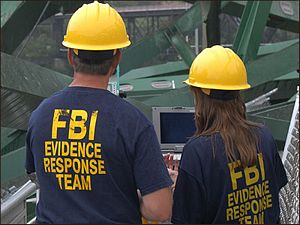 FBI Evidence Response Team members record damage to the I-35W bridge, which collapsed August 1 in Minneapolis. ERT members from the Minneapolis field office, as well as FBI offices in San Antonio, Pittsburgh, and Chicago, aided the federal probe, led by the National Transportation Safety Board. FBI Evidence Response Team members record damage to the I-35W bridge, which collapsed August 1 in Minneapolis. ERT members from the Minneapolis field office, as well as FBI offices in San Antonio, Pittsburgh, and Chicago, aided the federal probe, led by the National Transportation Safety Board.
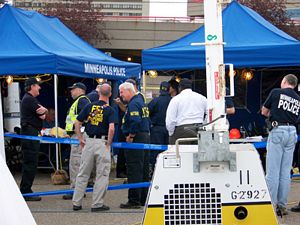 Agencies participating in the recovery efforts gather at an operations center near the collapse site. The National Transportation Safety Board (NTSB) was the lead agency in the federal bridge probe. Local agencies, like the Minneapolis Police Department and the Hennepin County Sheriff’s Office, coordinated the recovery response. Agencies participating in the recovery efforts gather at an operations center near the collapse site. The National Transportation Safety Board (NTSB) was the lead agency in the federal bridge probe. Local agencies, like the Minneapolis Police Department and the Hennepin County Sheriff’s Office, coordinated the recovery response.
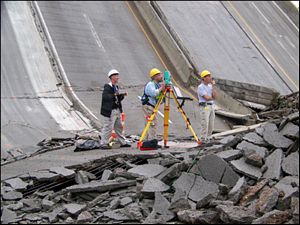 Members of the FBI’s Evidence Response Team (ERT) use surveying equipment to map the bridge’s debris field. By plotting millions of points, investigators create a digital representation of the fallen bridge, then marry the information with historical data to help determine what caused the fatal collapse. Members of the FBI’s Evidence Response Team (ERT) use surveying equipment to map the bridge’s debris field. By plotting millions of points, investigators create a digital representation of the fallen bridge, then marry the information with historical data to help determine what caused the fatal collapse.
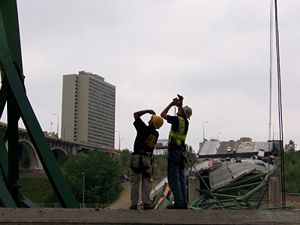 FBI and NTSB investigators survey the damage. FBI and NTSB investigators survey the damage.
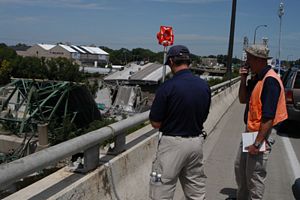 An FBI ERT member helps map the debris field of the I-35W bridge. The mapping method, called Total Station, takes precise measurements, which can be used to recreate the bridge collapse in digital form. An FBI ERT member helps map the debris field of the I-35W bridge. The mapping method, called Total Station, takes precise measurements, which can be used to recreate the bridge collapse in digital form.
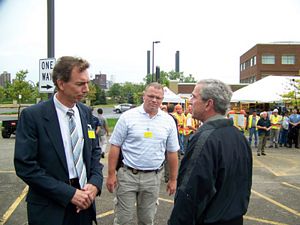 Minneapolis Assistant Special Agent in Charge Tim Gossfeld, left, confers with President Bush during the president’s visit to the disaster site. Minneapolis Assistant Special Agent in Charge Tim Gossfeld, left, confers with President Bush during the president’s visit to the disaster site.
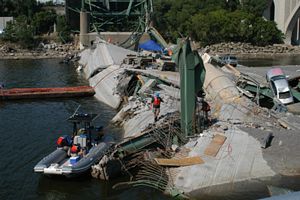 Divers from the FBI’s Underwater Search and Evidence Response Team probe the bridge wreckage for forensic evidence and missing victims. The agent on the right is lowering an underwater camera into the structure, while divers on the boat view footage from the camera. Divers from the FBI’s Underwater Search and Evidence Response Team probe the bridge wreckage for forensic evidence and missing victims. The agent on the right is lowering an underwater camera into the structure, while divers on the boat view footage from the camera.
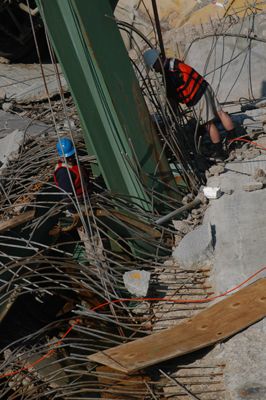 ERT members conduct a search for victims in the wreckage. Investigators attached an underwater camera to a long pipe to plumb the tight gaps beneath the structure. ERT members conduct a search for victims in the wreckage. Investigators attached an underwater camera to a long pipe to plumb the tight gaps beneath the structure.
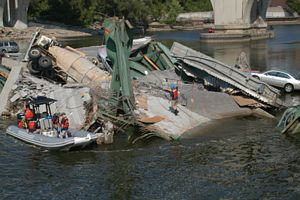 ERT members search for evidence. Divers used scanners and submersible remote operated vehicles to map the area around the bridge and to look for victims. ERT members search for evidence. Divers used scanners and submersible remote operated vehicles to map the area around the bridge and to look for victims.
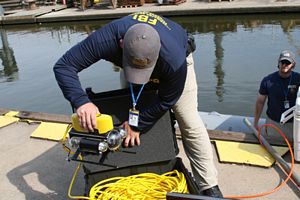 An FBI diver prepares the small remote operated vehicle (ROV) for operation. The ROV, the smaller of two that divers brought to the site, was able to explore areas underwater that divers might enter to look for victims or evidence. An FBI diver prepares the small remote operated vehicle (ROV) for operation. The ROV, the smaller of two that divers brought to the site, was able to explore areas underwater that divers might enter to look for victims or evidence.
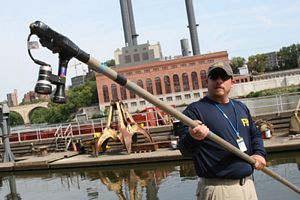 An FBI diver shows the underwater camera that was fastened to a pole to search tight spots in the rubble. An FBI diver shows the underwater camera that was fastened to a pole to search tight spots in the rubble.
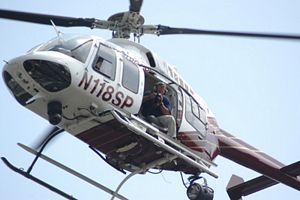 An ERT member photographs the site from above. An ERT member photographs the site from above.
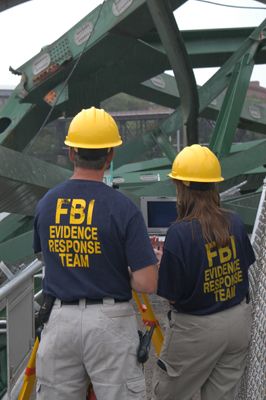 ERT members mapping the site sent their data to our Special Projects Unit, which worked with the NTSB to create a digital representation of the fallen bridge. ERT members mapping the site sent their data to our Special Projects Unit, which worked with the NTSB to create a digital representation of the fallen bridge.
|
Our Role in Bridge Collapse Probe
In the hours after the Interstate 35W bridge collapsed in Minneapolis, FBI agents were working their channels to determine if the span’s six-story, rush-hour fall was the result of a criminal or terrorist act. Agents probing the site looked much like you might expect at a typical raid or crime scene—their gear announcing their individual roles as FBI terrorism experts, bomb technicians, and evidence collectors.
In short order, however, as it became clear the collapse wasn’t a malevolent act, our presence took on a decidedly different hue. In the days after the August 1 collapse, FBI personnel were armed not with heavy weapons and armor but high tech mapping tools, underwater diving gear, and tons of equipment. Their mission: to help the agencies that were leading the probe recover victims and evidence and to determine what may have caused the fatal bridge failure.
The protocol for investigating events like this are mapped out well in advance through drills, joint operations, and agreements among agencies.
“The success of an operation like this doesn’t happen by chance,” said Minneapolis Special Agent Paul McCabe.
In this case, once criminal intent was ruled out, the National Transportation Safety Board (NTSB) took the lead in the federal bridge probe. The NTSB in turn has an arrangement with the Bureau to assist in gathering evidence in disasters to help pinpoint the cause. That set in motion our Evidence Response Team Unit at the FBI Laboratory in Virginia, which dispatched specially trained agents from around the country to aid the effort in Minneapolis.
Here’s a look at how we supported the probe:
Mapping the Scene: Supervisory Special Agent Gary Reinecke was wading though an Alabama landfill on a case when he received the NTSB call. Reinecke manages the FBI’s program for mapping debris fields and other forensic evidence at disaster scenes. The painstaking process involves surveying a site and mapping millions of points to create an accurate digital representation of the collapse aftermath. The raw information is then fed to the FBI Lab. Reinecke dispatched trained teams of agents from our Pittsburgh, San Antonio, and Chicago field offices to map the site using Total Station technology, which is like traditional surveying, and a three-dimensional laser scanner, which gives an enormous amount of detail to the digital maps. Reinecke chats weekly with the NTSB and their teams cross-train frequently, so he knew exactly what to do when the call came in. “We get involved in investigations from the get-go,” Reinecke said. “If we wait four days and it’s discovered that it’s terrorism, we’re already a month behind.”
Interpreting the Data: Much of the raw information that Reinecke’s crew gathers is sent to the FBI Lab, where the Special Projects Unit turns the data into visual representations. The unit may be best known for reconstructing crime scenes or facial imaging, but in this case the data on the I-35W bridge will be analyzed and sent to the NTSB. There, engineers marry the new data with historical information about the bridge to build elaborate computer scenarios that may help pinpoint a cause. A Special Projects team member was on site interpreting the data and feeding results to NTSB officials almost in real time.
Underwater Search: Early in the investigation the Hennepin County Sheriff’s Office sent divers to search for victims. After President Bush visited the site, the FBI and the U.S. Navy were summoned to send teams of divers to support the local search and recovery. Like Reinecke’s crew, the FBI divers’ role was to map the scene, only this time in a strong zero-visibility current strewn with bridge debris. “If we can see our hands in front of our face, that’s good visibility,” said Supervisory Special Agent Kevin Horn, program manager of the Lab’s Underwater Search and Evidence Response Team (USERT), who led FBI divers dispatched from our field offices in New York, Los Angeles, and Washington, D.C. The teams used sonar, underwater cameras, and remote-operated vehicles to plumb the debris field and look for passageways in and around “the pile” for divers to search for victims and forensic evidence. The divers are used to working under the worst circumstances—having been dispatched to Iraq—but the debris field in the Mississippi River presented its own challenges. “The entanglement risk is just constant,” said Horn.
Reinecke’s mapping team and Horn’s divers were each on the scene for just under a week, then headed back to their respective field offices to resume ongoing cases, each keeping a bag packed for the next call.
“We were asked to help,” Agent Horn said as he set off on a boat with his divers and a Sheriff’s deputy to look for evidence. “We’re here to assist and put our skills to good use. It’s a real tragedy, and our hearts go out to this city.”
Part I of this series looked at how we coordinate with federal, state, and local partners. Part III looks at the FBI’s initial response from the point of view of Assistant Special Agent in Charge Tim Gossfeld.

















 Topics: Interstate Highway System
Topics: Interstate Highway System
